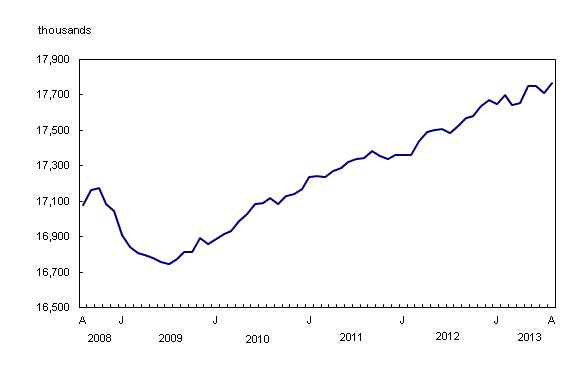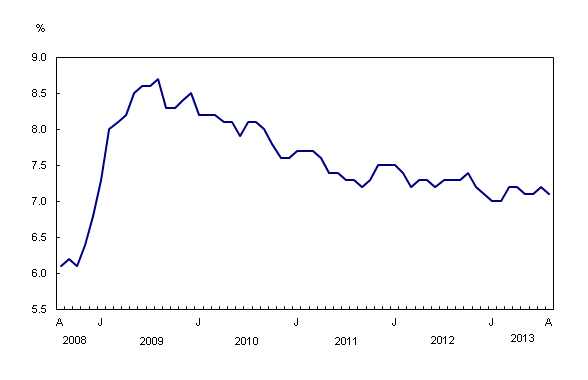Labour Force Survey, August 2013
Archived Content
Information identified as archived is provided for reference, research or recordkeeping purposes. It is not subject to the Government of Canada Web Standards and has not been altered or updated since it was archived. Please "contact us" to request a format other than those available.
Released: 2013-09-06
Employment increased by 59,000 in August, mainly in part-time work, and the unemployment rate declined 0.1 percentage points to 7.1%. Over the six months to August, employment gains averaged 12,000 per month, lower than the average of 29,000 observed during the preceding six-month period.
Since August 2012, employment has increased 1.4% (+246,000). At the same time, the number of hours worked has grown 1.3%.
Provincially, employment increased in Ontario and Alberta, while it declined in Manitoba.
Employment in health care and social assistance rose in August, offsetting a decline in July. There were also more people working in information, culture and recreation; accommodation and food services; and in construction. At the same time, there were fewer employed in educational services; "other services"; finance, insurance, real estate and leasing; and agriculture.
Employment gains were concentrated among people aged 55 and over, while there was little change among youths and people aged 25 to 54.
The employment rate of returning students aged 15 to 24 was up slightly this summer compared with last summer, but still low compared with rates prior to the 2008/2009 labour market downturn.
Employment up in Ontario and Alberta
In Ontario, employment increased by 44,000 in August, mostly in part-time work, and the unemployment rate was 7.5%. Compared with 12 months earlier, employment growth in the province was 2.2%, higher than the national average of 1.4%.
In August, employment in Alberta rose by 15,000, the fourth notable increase in five months. These recent gains have brought year-over-year employment growth to 3.6%. As more people searched for work in August, the unemployment rate rose 0.3 percentage points to 4.8%.
Employment in Manitoba declined for the second consecutive month, down 3,100 in August. At the same time, the unemployment rate decreased by 0.3 percentage points to 5.2% as fewer people were looking for work. Compared with 12 months earlier, employment in the province was little changed.
Despite little change in employment in Quebec, the unemployment rate declined 0.3 percentage points to 7.9% in August as there were fewer people looking for work. On a year-over-year basis, employment was little changed, as gains in the first five months of the period were offset by recent losses.
Industry perspective
In health care and social assistance, employment rose by 60,000 in August, more than offsetting the decline in July. Employment in this industry has been on a long-term upward trend and has increased by 2.5% since August 2012.
Employment increased by 33,000 in information, culture and recreation in August, countering losses over the previous two months. These gains brought employment to a level similar to that of 12 months earlier.
In August, the number of people working in accommodation and food services increased by 26,000. Employment rose by 3.9% compared with 12 months earlier.
Employment in construction rose by 18,000 in August. Following a recent low in August 2012, employment in this industry has increased 9.1%.
Employment in educational services declined by 22,000 in August and has fallen by 2.8% from 12 months earlier.
In August, employment in "other services" fell by 19,000, contributing to a 12-month decline of 4.1% in this industry.
There were 19,000 fewer people working in finance, insurance, real estate and leasing in August. Employment in this industry has been relatively unchanged over the previous 12 months.
Agriculture employment was down by 11,000 in August, bringing employment to the same level as 12 months earlier.
In August, there were 40,000 more people working as employees, mainly within the private sector. Over the previous 12 months, the number of employees increased 1.5% in the private sector, while it was little changed in the public sector. At the same time, self-employment rose 3.6%, driven mostly by gains in early 2013.
Employment gains among people aged 55 and over
In August, employment among people aged 55 and over rose by 52,000, with most of the gains among women. Compared with 12 months earlier, employment for men and women in this age group increased by 146,000 (+4.5%), partly a result of population aging.
Employment among youths aged 15 to 24 was little changed in August, and the unemployment rate was 14.1%. Youth employment has increased 1.7% since August 2012, mainly a result of gains in the first half of the period.
Among people aged 25 to 54, employment was little changed in August. Compared with 12 months earlier, employment for this group was up 0.5% (+61,000), with the gains coming in 2012.
Student summer employment
From May to August, the Labour Force Survey collects labour market data about young people aged 15 to 24 who were attending school full time in March and who intend to return to school full time in the fall. The published data are not seasonally adjusted; therefore, comparisons can only be made on a year-over-year basis.
The average employment rate for May to August for students aged 15 to 24 was 48.6%, up slightly from last summer (47.9%), and the same as the rate in the summer of 2009 (48.6%), when student employment was hard hit by the labour market downturn. In contrast, the rates averaged 54.1% in the summers of 2006 to 2008.
The employment rate for students aged 15 and 16 declined to 24.4% this summer, the lowest rate since comparable data have been available. On the other hand, employment rates rose for students aged 17 to 19 and 20 to 24 compared with last summer.
The average unemployment rate over the summer for students aged 20 to 24 was 11.2%, while it was 17.4% for those aged 17 to 19, and 28.8% for students aged 15 and 16.
The average number of hours worked at all jobs during the summer of 2013 by students aged 15 to 24 was 23.7 hours per week, down from 24.2 hours the previous summer. This was the first decline in hours among these students since the summer of 2009.
Note to readers
The Labour Force Survey (LFS) estimates are based on a sample and are therefore subject to sampling variability. As a result, monthly estimates will show more variability than trends observed over longer time periods. Estimates for smaller geographic areas or industries also have more variability. For an explanation of sampling variability of estimates and how to use standard errors to assess this variability, consult the "Estimates quality" section of the publication Labour Force Information (Catalogue number71-001-X).
The employment rate is the number of employed persons as a percentage of the population 15 years of age and over. The rate for a particular group (for example, youth aged 15 to 24) is the number employed in that group as a percentage of the population for that group.
The unemployment rate is the number unemployed as a percentage of the labour force (employed and unemployed).
The participation rate is the number of employed and unemployed as a percentage of the population. For more detailed information, see the Guide to the Labour Force Survey (Catalogue number71-543-G).
Unless otherwise stated, this release presents seasonally adjusted estimates, which facilitates comparisons by removing the effects of seasonal variations. For more information on seasonal adjustment, see Seasonal adjustment and identifying economic trends.
Each year, the LFS revises its estimates for the previous three years, using the latest seasonal factors.
A more detailed summary, Labour Force Information (Catalogue number71-001-X), is now available online for the week ending August 17. From the Browse by key resource module of our website under Publications, choose All subjects, then Labour.
Data tables are also now available online. From the Browse by subject module of our website, choose Labour.
The next release of the Labour Force Survey will be on October 11.
Contact information
For more information, contact us (toll-free 1-800-263-1136; infostats@statcan.gc.ca).
To enquire about the concepts, methods or data quality of this release, contact Jason Gilmore (613-951-7118; jason.gilmore@statcan.gc.ca) or Vincent Ferrao (613-951-4750; vincent.ferrao@statcan.gc.ca), Labour Statistics Division.
- Date modified:



